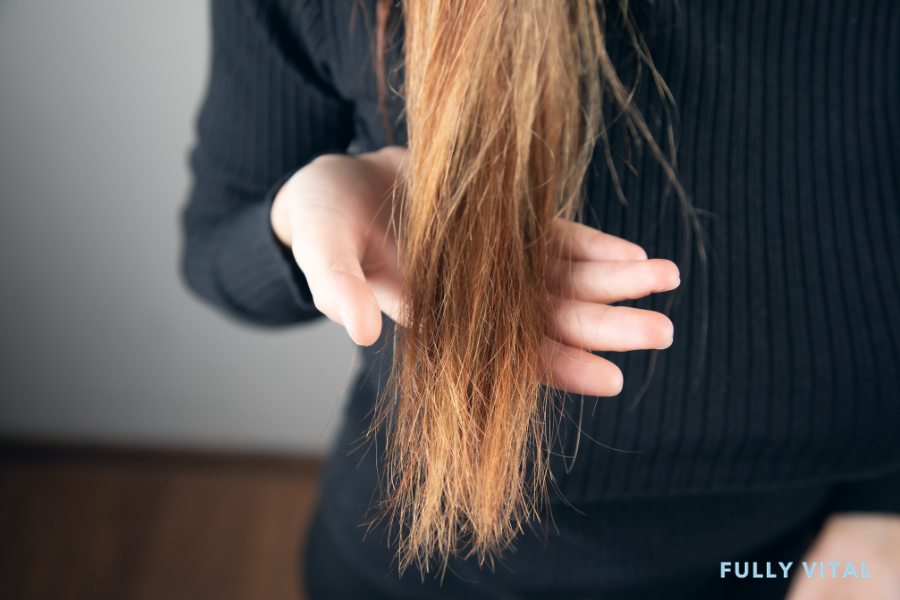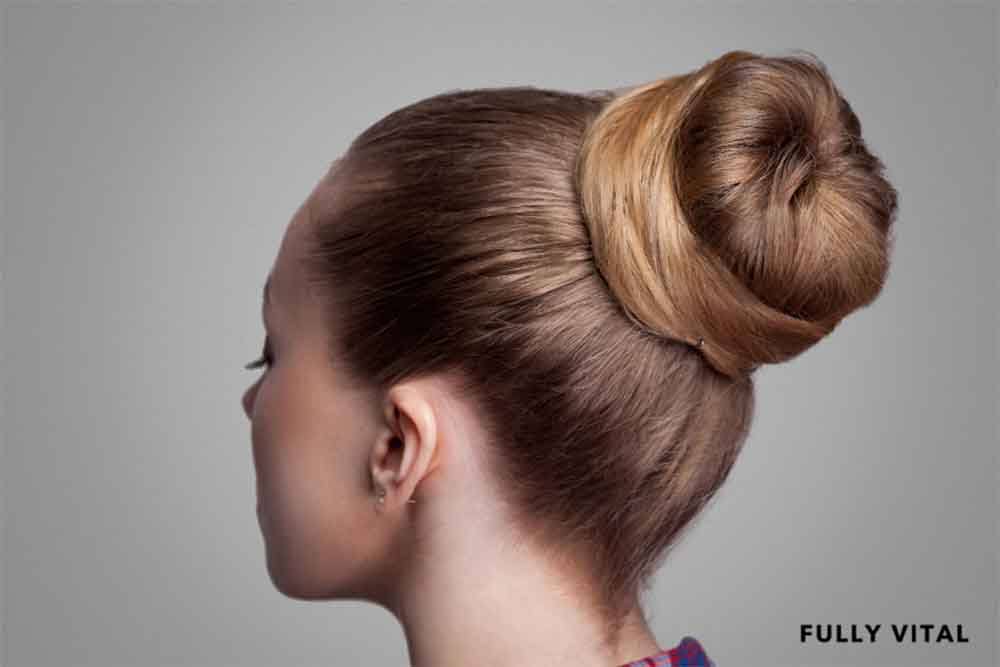
From Heat Styling To Chemical Treatments: Understanding The Different Types Of Hair Damage
Hair is not just about style, it's a reflection of ourselves.
However, we often ignore how styling, like using heat tools or chemicals, can damage it.
Understanding hair damage is key to preventing it, which is what we focus on at Fully Vital.
Frequent styling can age hair, but there's a lot of information to help us care for it properly.
We'll learn about hair damage types and how to protect our hair, making us think twice before using heat tools.
We'll also discover ways to promote hair growth, ensuring vibrant, healthy hair at any age.
At Fully Vital, we're dedicated to enhancing hair health and stimulating hair growth with science-based products, aiming for every day to be a good hair day.

I LOVE MY HAIR NOW
FullyVital hair serum and hair vitamins made tremendous improvements in my hair. I truly love my hair now.
Dorit S.,
Understanding Hair Damage: An Overview
Exploring the ways our hair can suffer from our daily routines and choices guides us in recognizing and preventing damage.
From surface-level cuticle issues to inner shaft problems, various factors contribute to hair damage.
The Heat Factor
Heat styling, while shaping our hair beautifully, can strip moisture, resulting in dryness, rough texture, split ends, and breakage.
Using protective measures becomes essential to avoid these issues.
Chemical Reactions
Chemical treatments like coloring or perming alter hair structure, weakening the shaft and causing breakage and moisture imbalance.
Achieving desired looks requires diligent care to counter potential damage.
Environmental Stressors
External elements like sun, wind, pollution, and hard water contribute to hair damage, leading to dullness, loss of shine, and color alteration.1
Recognizing the Signs
Signs such as excessive dryness, straw-like texture, increased tangling, thinning, and overall dullness indicate hair damage, signaling the need for extra care and attention.

Recognizing The Signs Of Healthy Hair
Understanding the traits of healthy hair is crucial amidst discussions of potential damage.
Recognizing these signs empowers better hair care decisions.
- Shine:Healthy hair often boasts a natural shine, reflecting light due to a smooth and sealed cuticle layer. Radiant hair that catches light signals good health and care.
- Texture: Smooth strands free of split ends signify strength and resilience. Hair should feel sleek and soft rather than rough and brittle, akin to comparing a silk ribbon to a frayed rope.2
- Elasticity: Healthy hair displays bounce and flexibility, resisting breakage during normal handling. When wet, it should stretch and return to its original length without snapping, indicating a well-moisturized structure and robust cortical strength.
- Scalp health: A nourished, supple scalp fosters healthy hair growth, devoid of excessive dryness, oiliness, or flakiness. A healthy scalp is the foundation for vibrant strands.
- ThicknessAnd Fullness: Often observed in healthy hair, thickness reflects minimized shedding and active hair follicles, influenced by both genetics and proper care practices.
Common Culprits: The Effects Of Excessive Heat Styling
Excessive heat styling, a prevalent issue in hair care, can significantly damage hair.
Understanding its effects is crucial for maintaining healthy locks.
Heat damage
Excessive use of tools like straighteners and blow dryers at high temperatures strips hair of natural oils, leading to dryness and increased breakage.
Similar to a lush forest besieged by drought, hair loses its vitality and strength due to prolonged exposure to high heat.3
Thermal Trauma
Heat causes irreversible damage to hair proteins like keratin, resulting in severe consequences such as split ends and a brittle texture.
The breakdown of these crucial building blocks weakens hair, making it more prone to breakage.
Moisture Loss
High heat acts as a catalyst for moisture loss, leaving hair dry and prone to frizz and static.
The evaporation of moisture, akin to a punctured water bottle, can lead to parched strands and unruly hair.
Exploring The Repercussions Of Chemical Treatments
Transformative as they are, chemical treatments come with risks.
While they can drastically alter hair, achieving effects like platinum blonde or keratin straightening, mishandling these treatments can lead to significant harm.
Hair Structure And Chemicals
Understanding the interaction between chemicals and hair structure is pivotal.
Keratin, the primary component of hair, shapes and strengthens it.
Treatments such as coloring or perming modify this structure by opening the protective cuticle layer, allowing chemicals to alter hair bonds.
Color Treatments And Bleaching
Bleaching profoundly lightens hair but causes substantial damage, stripping natural color and inducing dryness and brittleness.
Frequent bleaching leads to porousness, hindering moisture retention, dulling color, and increasing susceptibility to frizz and breakage.
Perms And Relaxers
Altering hair texture through these treatments weakens it by breaking and reforming natural bonds.
This process reduces elasticity, promoting breakage until the treated sections are trimmed off.
Overlapping Risks In Treatments
Overlapping, applying new chemicals to previously treated hair, exacerbates damage, making hair brittle and prone to breakage.
Often overlooked, it's a significant risk factor in chemical treatments.
The Role Of Hair Porosity
Chemical treatments significantly influence hair porosity, affecting its moisture absorption and retention.
Excessive processing can render hair highly porous, causing rapid absorption and loss of moisture, leading to ongoing cycles of damage and dryness.

Comparing The Impacts: Heat Styling Vs. Chemical Treatments
Exploring how heat styling and chemical treatments affect hair health helps us make better decisions about caring for our locks.
Understanding these differences guides us toward smarter hair care practices.
Heat Styling: The Gradual Wear and Tear
Regular heat styling slowly weakens hair's natural defenses, offering immediate results but accumulating long-term damage:
- Moisture Loss: Repeated heating leads to moisture evaporating from the hair, causing dryness.
- Cuticle Damage: Heat can cause the cuticle to lift and become damaged, leading to a rough texture and dull appearance.
- Split Ends and Breakage: When the hair becomes dry and brittle from constant heat, it's more prone to splitting and breaking, something we all tirelessly strive to avoid.
- Loss of Natural Curl/Wave Pattern: In curly or wavy hair types, excessive heat styling can actually relax the natural curl pattern over time.
Chemical Treatments: A Deeper Transformation
Chemical treatments profoundly alter hair chemistry, leading to invasive changes:
- Altered Hair Bonds: Chemicals break and reconstruct hair's keratin bonds, resulting in weakened, less elastic hair.
- Increased Porosity: Chemical treatments open the hair cuticle, making it highly porous and prone to moisture loss and tangles.
- Scalp Sensitivity: Chemical treatments may cause scalp irritation or allergic reactions, beyond impacting the hair shaft.
- Permanent Change Until Cut: Unlike heat damage, chemical alterations remain until the treated hair grows out or is cut off, lacking reversibility through conditioning or treatments.
Experience The Power Of Youthful, Vibrant Hair With Fully VitalAre you ready to revolutionize your hair care routine? At Fully Vital, we understand the intimate relationship between you and your hair. Our specially crafted hair growth products are designed to not only slow down but also potentially reverse the aging process of your hair, offering you a chance to rejuvenate your tresses and bring back their youthful glow. Here's what makes our products a must-try:
Don't wait to fall back in love with your hair. Let Fully Vital bring out the best in your locks with treatments that promise a healthier, more confident you. Embrace the transformation – because your hair deserves to be as Fully Vital as you are. |
Final Thoughts On The Different Types Of Hair Damage
Using heat styling or chemical treatments to get the hairstyle we want can harm our hair.
It's important to know about different kinds of hair damage so we can take care of our hair properly.
Damage from heat styling builds up slowly but can be lessened with protective steps and not overdoing it.
Chemical treatments can cause immediate and deep damage, so it's important to think carefully and maybe get help from a professional.
At Fully Vital, we want to help you keep your hair healthy and growing, even with styling and environmental stress.
With the right care and our products based on science, you can reduce damage and keep your hair looking naturally beautiful and strong.
Your hair shows how well you take care of yourself.
Let's work together to make every day a day for healthy, vibrant hair.
Here are our recent blogs:
- Hair Breakage Demystified: Unveiling the Factors and Strategies for Prevention
- Hair Follicle Pain: What It Means and How to Treat It
- From Diet to Hormones: Exploring the Hidden Causes of Greasy Hair
Frequently Asked Questions About The Different Types Of Hair Damage
How do I know if my hair is damaged beyond repair?
If your hair has consistent dryness, excessive breakage, thinning, and lack of elasticity and does not respond to any form of conditioning or treatments, it might be damaged beyond repair.
In such cases, cutting the hair might be the best option for a fresh start.
What does over processed hair look like?
Over processed hair often looks dull, feels dry and brittle, with split ends and frizz. It can also have a straw-like texture and appear lifeless due to the destruction of the hair's natural keratin.
Does damaged hair grow back?
Hair will continue to grow from the roots even if it's damaged.
However, severe damage can cause hair follicles to become dormant and potentially lead to hair thinning or balding.
Proper care and using growth products can help in restoring its health.
What damages your hair the most?
The most hair damage is often caused by heat styling tools, chemical treatments like bleaching and perms, as well as harsh haircare products, and environmental factors such as UV exposure and extreme weather conditions.
How long does damaged hair take to heal?
The time it takes for damaged hair to heal can vary.
It might take several weeks to a few months of consistent care and the avoidance of damaging habits.
Severely damaged hair, however, may need to be cut as the damaged ends cannot be revived.
How do I know if my hair needs repair?
Signs your hair needs repair include a rough texture, split ends, tangles, lack of shine, and an overall brittle and dry appearance.
If your hair lacks softness and elasticity, it likely needs some TLC.
What are the two most common problems for your hair?
The two most common problems are typically hair breakage and split ends.
These conditions occur due to various types of stress on the hair such as mechanical, thermal, and chemical stress.
How do you treat hair breakage?
To treat hair breakage, minimize the use of heat styling tools and harsh chemical treatments, use a deep conditioning treatment regularly, trim your ends to prevent further splitting, and ensure a protein-rich diet or protein treatments to strengthen your hair.
What hairstyle prevents hair damage?
Hairstyles that prevent hair damage are typically those that do not pull or stress the hair.
Loose buns, braids, and leaving your hair down more often can reduce tension and subsequently hair damage.
How do you fix chemically damaged hair?
Fixing chemically damaged hair involves a combination of cutting off severely damaged parts, reducing or eliminating further chemical processing, using hydrating and restorative hair treatments, limiting heat styling, and maintaining a healthy diet to support hair regrowth.
Using quality hair growth products can also aid in the repair process.
Sources:
- Sebetić, K., Sjerobabski Masnec, I., Cavka, V., Biljan, D., & Krolo, I. (2008). UV damage of the hair. Coll Antropol, 32(Suppl 2), 163-165. Retrieved from https://pubmed.ncbi.nlm.nih.gov/19138021/
- Yang, F.-C., Zhang, Y., & Rheinstädter, M. C. (2014). The structure of people’s hair. PeerJ, 2, e619.
- Lee, Y., Kim, Y.-D., Hyun, H.-J., Pi, L.-q., Jin, X., & Lee, W.-S. (2011). Hair Shaft Damage from Heat and Drying Time of Hair Dryer. Annals of Dermatology, 23(4), 455–462. https://doi.org/10.5021/ad.2011.23.4.455







